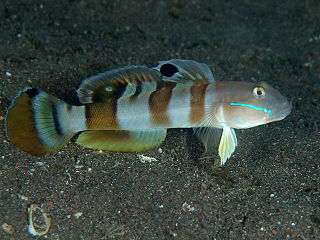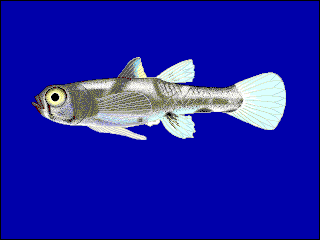Eviota readerae is a species of goby associated with reefs and tide pools. It has a very limited distribution in the southwest Pacific, being found only on the Elizabeth and Middleton Reefs and the Lord Howe Rise in the Tasman Sea.
Glossogobius hoesei, Hoese's goby, is a species of goby endemic to the Ayamaru Lakes in West Papua, Indonesia where it can be found on muddy or gravel substrates as well as in small tributary streams. This species can reach a length of 7 centimetres (2.8 in) SL. The specific name honours the ichthyologist Douglass Fielding Hoese of the Australian Museum in Sydney who has made an important contribution to the study of fishes in the order Gobiiformes.
Silhouettea is a genus of gobies native to the Indian Ocean and the western Pacific Ocean. The name of this genus refers to the island of Silhouette in the Seychelles where the type specimens of the type species, Silhouettea insinuans, were collected.

Valenciennea wardii, Ward's sleeper,Ward's sleeper goby, is a species of goby native to the Indian Ocean and the western Pacific Ocean in bays, reefs and lagoons at depths of from 12 to 35 metres. It can be found on sandy or silty substrates. This species can reach a length of 15 centimetres (5.9 in) SL. It can also be found in the aquarium trade. The specific name honours the United Kingdom diplomat Swinburne Ward (1830-1897) who was Her Majesty's Civil Commissioner for the Seychelles, although this species was described from specimens collected off Zanzibar.

Koumansetta rainfordi, the old glory or Court Jester goby, is a species of goby native to tropical reefs of the western Pacific Ocean where it occurs at depths of from 2 to 30 metres. This species can reach a length of 8.5 centimetres (3.3 in) SL. It can also be found in the aquarium trade. The specific name honours the viticulturalist E. H. Rainford, of the Queensland Agricultural Department, who also collected specimens for the Australian Museum, and in 1924 he collected specimens of this species.

Amblyeleotris wheeleri, the Gorgeous prawn-goby, is a species of goby native to tropical reefs of the Indian Ocean to the western Pacific Ocean. It can be found at depths of from 5 to 40 metres though is usually does not occur deeper than 15 metres (49 ft). It is a commensal with alpheid shrimps, most often being found in association with Alpheus ochrostriatus. This species can reach a length of 10 centimetres (3.9 in) SL. It can also be found in the aquarium trade. The specific name honours the English ichthyologist Alwynne Cooper Wheeler (1929-2005), who was curator of Fishes at the British Museum, "for his help over the years, particularly with the authors’ study of prawn-associated gobies of the Seychelles".

Koumansetta is a small genus of gobies native to the Indian Ocean and the western Pacific Ocean. The name of this genus honours the Dutch ichthyologist and goby taxonomist Frederik Petrus Koumans (1905-1977) of the Rijksmuseum van Natuurlijke Historie in Leiden, Netherlands, who had written a description of Koumansetta rainfordi following a visit to the Australian Museum in Sydney in 1938 but did not name it. The outbreak of World War II meant that Whitley's correspondence with Koumans was interrupted, so he named this genus after him, noting “which will enshrine memories of happier days of our meetings in Leiden and Sydney”.

Elacatinus evelynae, the sharknose goby, Caribbean cleaner goby, Caribbean cleaning goby, is a species of goby native to the Western Atlantic Ocean from the Bahamas and the Lesser Antilles to the northern coast of South America, as well as the Antilles and western Caribbean.
Barbuligobius boehlkei, the Cryptic bearded goby, is a species of goby native to the Indian Ocean and the western Pacific Ocean where it can be found on sand-rubble substrates at depths of from 1 to 15 metres. This species grows to a length of 2 centimetres (0.79 in) SL. This species is the only known member of its genus. Its specific name honours James E. Böhlke (1930-1982) of the Academy of Natural Sciences of Philadelphia.
Antilligobius is a genus of goby. It contains only the species Antilligobius nikkiae, the sabre goby, which is native to deep waters of the western Atlantic Ocean. The specific name honours Nicole Laura Schrier, the daughter of the owner of the Sea Aquarium in Curaçao, who collected many of the type specimens.

Valenciennea helsdingenii is a species of goby from the Indo-Pacific. It is commonly known as the twostripe goby, black-lined sleeper goby, or railway sleeper goby. It can grow up to a length of 25 cm (9.8 in) and is distinguishable by two prominent orange to black lines running longitudinally through its body.
Ebomegobius goodi is a species of brackish water goby native to a stream in Cameroon and is known from a single specimen. This species grows to a length of 3.5 centimetres (1.4 in) SL. This species is the only known member of its genus. The genus name is a compound of Ebomé, the brackish stream where the species was found, and gobius while the specific name honours the missionary Albert Irwin Good (1884-1975), who collected West African fishes and collected the type of this species.
Echinogobius hayashii, the cheek-streaked goby, is a species of goby native to the eastern Indian Ocean and the western Pacific Ocean from Australia to Japan. This species can be found at depths of from 1 to 20 metres living in areas with strong tidal currents and a sandy substrate. This species grows to a length of 7 centimetres (2.8 in) SL. This species is the only known member of its genus. The specific name honours Masayoshi Hayashi, a curator at Yokosuka City Museum, who collected the type specimens.
Cable's goby is a species of goby endemic to reefs around the Galápagos Islands. This species grows to a length of 7 centimetres (2.8 in) SL. This species is the only known member of its genus. The specific name honours the United States Government biologist Louella E. Cable (1900-1986), who illustrated this goby for the describer Isaac Ginsburg, and drew his attention to its separated ventral fins.
Ginsburgellus novemlineatus, the Nineline goby, is a species of goby native to tropical reefs of the western Atlantic Ocean and the Caribbean Sea. It is frequently found associated with the sea urchin Echinometra lucunter, living underneath the urchin. This species grows to a length of 2.5 centimetres (0.98 in) TL. This species can also be found in the aquarium trade. This species is the only known member of its genus, the name of which honours the ichthyologist Isaac Ginsburg (1886-1975) of the U.S. National Museum who had an interest in gobies.

Sicydium plumieri is a freshwater species of the goby native to the Antilles from Cuba to Trinidad and Tobago, though not recorded from all islands. This species can reach a length of 11 centimetres (4.3 in) TL. It is also known by the English common names sirajo, Plumier's stone-biting goby, and tri-tri goby. The young, which are regarded as a delicacy, are of commercial importance. The specific name honours Charles Plumier (1646-1704), a Franciscan friar and naturalist, who found the first specimens of the species on Martinique and Marcus Elieser Bloch based his species description on Plumier's drawings.
Hyrcanogobius bergi, the Volga dwarf goby, is a species of goby endemic to the Caspian Sea where it occurs in fresh, brackish and marine waters along the coast. Unusually for gobies, this species is almost a pelagic fish. This species grows to a length of 3.6 centimetres (1.4 in) SL. This species is the only known member of its genus. The specific name honours the Soviet zoologist Lev Berg (1876-1950) who described many new species of goby from the Caspian Sea.

The largetooth goby, also known as Wilbur's goby, is a species of ray-finned fish from the family Gobiidae which is native to the Indo-Pacific from the Seychelles to Micronesia. Its known range has been extended to the Red Sea as specimens were photographed at one site and collected at another site off Egypt. This species lives in sheltered marine waters at depths of from 0 to 20 metres preferring areas with sandy substrates. This species grows to a length of 6.5 centimetres (2.6 in) SL. This species is the only known member of its genus. This species is not obviously sexually dimorphic and it has a background colour of pale brown to greenish-brown and a pale ventral side. The body is marked with brown and white spots, pairs of larger brown spots create a mid-lateral row along its flanks and there is a dark spot on the caudal fin peduncle. It has a brown blotch on the cheek and a series of short brown bars along its back. The largetooth goby is a solitary fish which is found in coastal bays, lagoons and estuaries over fine sandy substrates close to the margins of reefs or silt beds in the vicinity of sheltered and often turbid coastal reefs. It is most frequently collected from shallow waters to 7 metres (23 ft), around coral reefs but off southern Japan, the largetooth goby occurs at the bottom of sandy bays. The specific name honours the American physician, Ray Lyman Wilbur (1875–1949) who was president of Stanford University from 1916–1943, as well as being the United States Secretary of the Interior from 1929–1933. Wilbur helped the author, Herre, get to Palau, the type locality of this species.

Pandaka is a genus of fish in the goby subfamily, Gobionellinae, native to fresh, brackish and marine waters of Asia and the western Pacific Ocean. Some species in the genus are among the smallest fish in the world; the male P. pygmaea can be just 9 mm (0.35 in) in standard length at maturity.

Parasicydium bandama is a species of goby native to fast-flowing streams and rivers of Cameroon, Congo, Gabon and the Ivory Coast. This species grows to a length of 5.4 centimetres (2.1 in) TL. This species is the only known member of its genus. The genus refers to this species resemblance to members of the genus Sicydium while the specific name is the name of the Bandama River in the Ivory Coast where the type specimen was collected.











